Rome Ancient Appian Way - Appia Antica: maps and aerial view
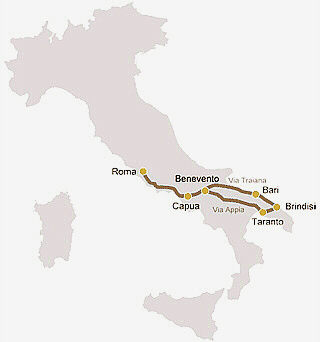 |
The Appian Way or Via Appia was also called Via Sacra (Sacred Way), and dubbed Regina Viarum (Queen of Roads) because it lead to the original settlements of the Latins in the Alban Hills, and then onto Brindisi and Greece.
Index
You can see in the left map of ancient Italy the route of the road.
In the initial section, near Rome, it was a highly monumental and scenic road. It then connected thriving towns and regions of Southern Italy, and it finally reached Brindisi, the gateway to Greece and to the East, which where the cradle of Mediterranean civilizations.
|
VILLAS FOR RENT IN THIS AREA
Villa in the Appian Way park in Rome : scenic and sophisticated villa with pool, with large garden, ideal for refined parties and weddings, with exquisite catering, for 12-200 persons. It can also host 12 persons in 6 suites. It allows archaeological excursions, and also nearby golf, biking, and tennis.
Villa di Fiorano - along the Appian Way near Rome:
"Fiorano", an amazing elegant 18th century large
villa, with large park, fountains and swimming pool
- suitable for celebrations, weddings and parties, with fine catering. |
Only the section near Rome retains the original route and general aspect, after 2,300 years since it was first paved.
In this first tract, two parallel contemporary roads run along it, the Appia Pignatelli and the Appia Nuova. Only after the ancient Bovillae (the present Frattocchie) the modern road was paved on the ancient one, and it thus looks like many roads in Italy, although every now and then it is flanked by ancient monuments and ruins.
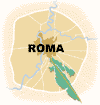
The first, and ancient tract, and its surrounding areas were transformed into an archaeological park, to preserve its historical and natural resources, and its landscape. The park is one of Rome's most acclaimed sights, and it is visited by tourists all year round.
With the inception of the park, building within it is strictly forbidden. Only the few pre-existing villas built generally during the 19th and in the early years of the 20th century were condoned and thus authorized to remain. These rare villas are thus highly desirable, as they are surrounded by one of the most spectacular and beautiful parks in the world, rich of archaeological monuments and works of art, practically in Rome's centre. They are rare, and consequently priceless.
The above small map gives you an idea of the layout of the archaeological park compared to all Rome's layout. The small brown area is what Romans call "Centro Storico" or "Historical centre", which is encircled by the Aurealian Walls (the "Centre" for tourists). All areas around it within a radius of 3-4 kilometers are still considered "Centre" by Romans.
Romans regards all areas within the large ring of Rome still as "Central". To find a villa with garden nowadays you need to go outside the ring. As mentioned, only very few fortunate persons own villas in the Appian Way park, thus not only in the centre, but also surrounded by a most amazing archeological and natural area. |
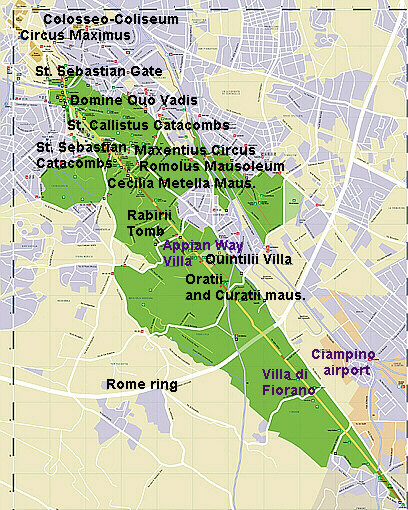 |
|
|
An aerial view of the Circus of Maxentius, and to its left, the House and the Mausoleum of Romulus, the founder of Rome, encircled by rectangular walls.
The photo enables a view of the northern area of the park, bordering the "Centro Storico", which is encircled by Marcus Aurelius' Walls. The Appian Way Park appears like a green oasis in Rome's centre. |
The right aerial photo shows the Mausoleum of Cecilia Metella, the adjoining Caetani palace, and the ruins of a monastery in front of them (on the other side of the road).
The Caetani were a noble family originating from the present Gaeta. They imposed heavy tolls to pass through the Appian Way, which brought over time to the formation of two new parallel roads, the Appia Pignatelli and the Appia Nuova, to bypass the tolls. However, because of this, nowadays we still have a preserved ancient Appian Way. |
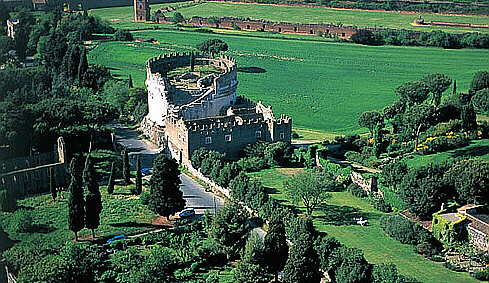
|
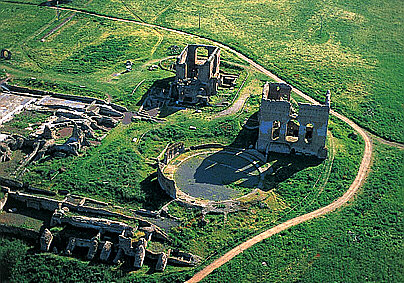 |
To the left you can see an aerial view of the Quintilii Villa (Villa dei Quintili). It is situated between the Appian Way road and the present Appia Nuova, on which you find also a museum with the archaeological finds of the area. A team of archaelogists works permanently in this area.
Nearby you also find the tomb of the Orazii and of the Curiatii, the champions of Rome and of Albalonga, in the first epic war of Rome and its neighbours. |
|

![]()
